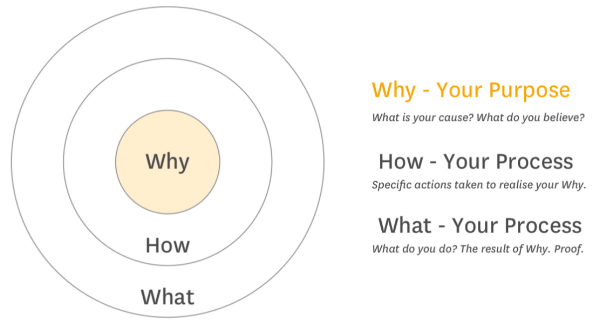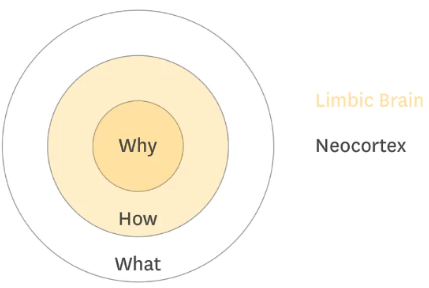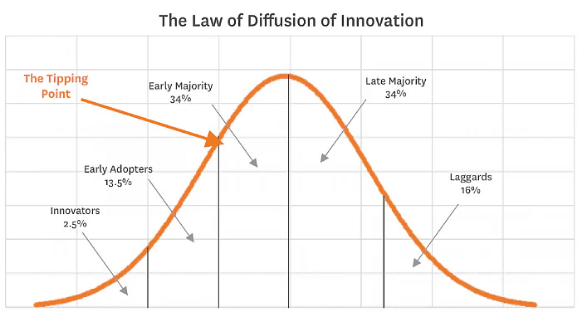Summary: Start with Why | Summaries: Must Read Books for Entrepreneurs - Entrepreneurship PDF Download
Chapter 1: Assume You Know
- The first chapter of “Start With Why” dives into the assumptions we make and the impact they have on our actions. Sinek gives examples of scenarios where looking at the bigger picture can shape your behavior towards driving long-term results. Take the classic example of American car manufacturers versus the Japanese. In American car factories, workers on the assembly line apply final fixes on doors using a rubber mallet, whereas in Japan the doors are engineered to fit perfectly from the start.
- This is also a metaphor for leadership. There are two types of leaders: those who decide to manipulate to get to the end result, and those who start with the end result in mind and let everything else naturally fall into place.
Chapter 2: Carrots and Sticks
- According to Sinek, there are two ways to attract customers: inspiring the carrots or manipulating the sticks. Most of the sales tactics used by businesses today involve manipulation. These include price, promotions, fear, aspirations, peer pressure, and novelty. Pricing and promotions are the most commonly identified forms of sales manipulation, but fear, aspirations, peer pressure, and novelty tend to be more discrete.
- Regardless of the type of manipulation, it is important to understand these are short-term solutions which end up leading to a cycle of repeated manipulation. Continuing too far down this path will impact long-term profitability, but there is another way which is revealed in chapter three.
Chapter 3: The Golden Circle
The core of Simon Sinek’s “Start With Why” is his discovery of The Golden Circle. There are three parts of The Golden Circle: Why, How, and What.
- Why: Very few people or companies can clearly articulate why they do what they do. This isn’t about running a profitable company—that’s a result. Why is all about your purpose. Why does your company exist? Why do you get out of bed in the morning? And why should anyone care?
- How: Some people and companies know how they do what they do. Whether you call them a ‘’differentiating value proposition’’ or a ‘’unique selling proposition,’’ HOWs are often given to explain how something is different or better.
- What: Every single company on the planet knows what they do. This is true no matter how big or small the company is, or no matter what industry they belong to. Everyone can easily describe the products or services their company sells or the job function they have within the company.
- When we start with “Why”, we go from the inside out of the circle. “Why” is the reason to buy and the “Whats” merely represent the tangible products as a proof of that belief. “Whats” are the reasons we can point to rationalize why we so much like a company over another.
- Simon Sinek cites the example of Apple. In his opinion, Apple is technically no different from its competitors. But Apple communicates from the “Why.” Apple’s “Why” is to challenge the status quo and empower the individual. And their challenging the status quo is a pattern repeating in all they say and do, which is the reason why people perceive Apple as authentic.
Chapter 4: This Is Not Opinion, This Is Biology
Chapter four begins by focusing on human nature’s desire to belong. This desire drives us to pursue others who share the same “Why” as us. And oddly enough, the Golden Circle matches the way our brain operates.

- Neocortex: Our neocortex, corresponds with the “What” level. This is responsible for all our rational and analytical thought and language. This allows us to look through vast amounts of facts and figures, but it doesn’t drive behavior.
- Limbic Brain: The middle two sections make up our limbic brain and are responsible for all of our feelings, like trust and loyalty. This roughly corresponds with the “Why” level. This area of the brain is responsible for all human behavior and all our decision making.
- We want to be around people and organizations who are like us and share our beliefs.
- When companies start with “Why”, with what they believe, they will tap into our innate drive to include those products as symbols of our values and beliefs. They make us feel special like we belong to something bigger, and we feel a sense of tribe affiliation with all the others buying the same products.
- Most companies generally start with “Whats” and “Hows” because that’s what their customers ask for. They ask for great quality, low price, 24-hour service and lots of features.
- And it’s all scientifically sounding because it’s based on data. But according to Simon Sinek, that’s a load of baloney. The part of the brain controlling decision making is different from the part of the brain reporting back “Why” that decision happened. So all those focus groups and questionnaires are probably of little value.
Quoting Henry Ford, “If I had asked people what they wanted they would have said a faster horse.”
Chapter 5: Clarity, Discipline, and Consistency
Chapter five continues down the path of explaining how the Golden Circle is important, but ONLY in the right order.
The three degrees of certainty:
- When we can only point to tangible elements or rational measurements, the highest level of the confidence we can give is: “I think this is the right decision.”
- When we make gut decisions, the highest level of confidence we can offer is: the decision feels right, even if it flies in the face of all the facts and figures.
- The ability to put a “Why” into words provides the emotional context for decisions. When you know your “Why”, the highest level of confidence you can offer is: “I know its right.” When you know the decision is right, not only does it feel right, but you can also rationalize it and easily put it into words.
- The goal of business should not be to do business with anyone who simply wants what you have. It should be to focus on the people who believe what you believe.
Chapter 6: The Emergency of Trust
Trust begins to emerge when we see that people and organizations are driven by reasons that go beyond the self-serving. Aligning Why, How and What is a way to build that trust.
“What” and differentiation
- Companies that act like commodity producers have a constant challenge to differentiate themselves from the competition. Chasing the competition, trying to match them feature-for-feature only deepens the “What” culture.
“Why” and flexibility
- Because consumers are inspired by “Why” you do what you do, companies that begin communicating with the “Why” have a greater flexibility in the market. Take the example of Apple and Dell. Apple makes computers. Apple also makes iPads and iPhones.
- Dell, on the other hand, is defined by “What” they do. Dell does computers, so consumers don’t feel comfortable buying anything else from them like say, a tablet or a smartphone. They tried expanding into different verticals but quickly retreated to “focus on their core business”.
- Simon Sinek also cites the First Mover Advantage when “Why” is in the picture. Take the case of Creative versus Apple. Creative was far more capable of producing an mp3 player, and they were the first. But they marketed their offering as a “5GB mp3 player”, more like a “What.” Instead, Apple marketed the iPod as “1000 songs in your pocket” giving us the “Why” that we need.
“Why” and hiring
- When employees belong, they will guarantee your success. And they won’t be working hard and looking for an innovative solution for you, they will be doing it for themselves.
- The goal is to hire those who are passionate about your “Why”, your purpose, cause or belief, and who have the attitude that fits your culture. Once that is established, only then should their skillset and experience be evaluated.
- Great companies do not hire skilled people and motivate them; they hire already motivated people and inspire them. Companies with a strong sense of “Why” are able to inspire their employees. Such employees are more productive and innovative, and the feeling they bring to work attracts other people eager to work there as well.
Chapter 7: How a Tipping Point Tips
How do you differentiate between a fad and an idea that can change lives forever?
- The Law of Diffusion of Innovations stated by Everett M. Rogers pertains to the bell curve of product adoption. The curve outlines the percentage of the market who adopt your product, beginning with the Innovators (2.5%), followed by Early Adopters (13.5%), Early Majority (34%), Late Majority (34%) and Laggards (16%).
- The ones who queued up for hours, or days outside an Apple store to buy the latest iPhone are all early adopters and belong to the left side of the curve. The people on the far right instead are never content and never loyal. For a business, it would be prudent to get to know the far right side of this curve better, so that you don’t waste time and money in trying to convert them. While some of them might end up doing business with you, they’ll probably switch to one of your competitors at the drop of a hat if they get a better deal.
- The goal of a business then is to be crystal clear about their “Why” and find people who believe what you believe. Once you get enough of the 15-18% on the left side of the bell curve, they will encourage the rest to follow.
Chapter 8: Start With Why But Know How
- Energy motivates but charisma inspires. Energy is easy to see, measure and copy. All great leaders have charisma because all great leaders have clarity of “Why”; an undying belief in a purpose or cause bigger than themselves.
- Sinek cites the example of Bill Gates and Steve Ballmer. Steve Ballmer was energetic. Bill Gates, in spite of being shy and awkward, is charismatic. When Steve Ballmer speaks people are energized, but that tends to dissipate quickly. When Bill Gates speaks people listen with bated breath. They remember those lessons for weeks, months or even years. Charisma commands loyalty while energy doesn’t.
“Why” and “How” Types
- Behind every “Why” type of leader, is a “How” type of leader who brings the “Why” to life.
- “Why” types are the visionaries with overactive imaginations. They tend to be optimists who believe that everything they can imagine can be accomplished and they tend to be focused on things most people can’t see, like the future. “How” types instead are more practical and more realist and tend to be focused on the things most people can see and tend to be better at building them.
- Interestingly, Simon Sinek says that “How” types can be very successful but rarely do they build billion dollar businesses that change the world. And while a “How” type doesn’t necessarily need a “Why” type to succeed, a “Why” type always needs a “How” type or they’ll end up as starving visionaries.
Vision and Mission Statement
- The difference between “Why” and “How” types also introduces the difference between the vision and mission statements of an organization.
- The vision is the founder’s intent, “Why” the company was founded. The mission is a description of “How” the company will create that future.
- When both are clear, it will help the “Why” and the “How” type of leaders to have clearly defined roles in the partnership.
Chapter 9: Know Why. Know How. Then What?
- When a company is small, a founder has plenty of direct contact with the outside world. As it grows the leader’s role changes. He/she will no longer be the loudest part of the megaphone; he/she will become the source of the message that is to flow through the megaphone.
- The “Why” exists in the part of the brain that control feelings and decision making but not language. “Whats” exist in the part of the brain that controls rational thought and language.
- The leader is the inspiration, the symbol of the reason we do what we do. They represent the emotional limbic brain. What the company says and does represent the rational thought and language of the neocortex.
- Most companies struggle to differentiate or communicate their true value to the outside world. When we as human beings struggle to put emotions into word, we rely on metaphors, imagery, and analogies in an attempt to communicate how we feel. We use symbols. We create tangible things for those who believe in what we believe to say. If done properly, that’s what marketing products and services are; a way for organizations to communicate to the world outside.
Chapter 10: Communication is about Listening
- Symbols help us turn the intangible into tangible. And the only reason symbols have meaning is because we give them a meaning. A logo can only become a symbol when it inspires people to use it to say something about who they are.
- Take the example of Harley Davidson: Harley Davidson embodies the values and lifestyle of the people wearing it. The symbol is no longer about Harley Davidson. Instead, the logo embodies an entire value set—their own. The symbol is no longer about Harley, it’s about the people who love Harley Davidsons for what they are.
The Celery Test
- What’s good for your competition is not good for you and vice-versa. But how do you know what is good for you and what isn’t? To do this, Sinek proposes The Celery Test.
- Imagine if people told you that to grow you need cookies, Nutella, celery, fruits and ice cream. Should you get them all? No, because it’s time-consuming, expensive and scatterbrained. What you do is to filter everything through your “Why.” So, if your “Why” is to lead a healthy lifestyle, you’d probably pick only the fruits and/or the celery. When you filter your decisions through your “Why” you save money, time and, most importantly, you stay true to your cause.
Chapter 11: When Why goes Fuzzy
- In this chapter, Sinek talks about companies which have lost sight of their original “Why.” Take the example of Volkswagen and Walmart. Volkswagen literally means “car of the people” and its image has always been that of reliable, affordable cars for everyone. The original VW Beetle was a cheerful symbol of freedom and a simple, carefree life. So when they introduced the super-expensive, $70,000 VW Phaeton, that flew against their own “Why” and sold nothing.
- Walmart was a more serious case. Walmart was started by Sam Walton with the idea of helping people and communities by providing products at low prices. However, after the death of its founders, the company focused only on low prices, forgetting about helping people and the communities they entered. It ended up becoming a cutthroat business towards its suppliers, employees and the communities it was a part of. Walmart got into serious trouble when it lost its initial “Why.”
- Sinek says that gaining a clarity of “Why” is not the hardest part. The hardest part is the discipline to trust one’s gut over outside advice and to stay true to your cause or belief.
Chapter 12: Split Happens
- An Idea. That’s probably where every company starts. At the beginning, ideas are fueled by passion. That very compelling emotion that sometimes causes us to do irrational things.
- But for passion to thrive and survive, it also needs structures and “Hows.” Most companies fail because both “Hows” and “Whys” need each other.
Chapter 13: The Origin of a Why
- You’ve probably heard that before you start a business, market research is key. You do your market research, know your customer and then build your niche. Sinek, however, disagrees. According to Sinek, the “Why” does not come from looking ahead at what you want to achieve and then figuring out an appropriate strategy to get there. It is not born out of market research or for that matter even extensive interviews with customers or employees. It comes from looking in the completely opposite direction from where you are right now. Finding the “Why” is a process of discovery, not invention.
- The “Why” is within you. And once you find and know your “Why”, the hardest part is to remain true to it.
Chapter 14: The New Competition
- When you’re up against the world, competing with everyone else, no one wants to help you. But when you compete against yourself, everyone wants to help you.
- Now let’s think about how we do business. We’re always competing against someone else. Better quality. More features. Better service. We’re always comparing ourselves to the competition. And no one wants to help us.
- What if we showed up to work every single day to be better than ourselves? For no better reason than to want to leave the organization in a better state than we found it?
- All organizations start with “Why”, but only the great ones keep their “Why” clear year after year. Those who forget “Why” they were founded show up to the race every day to outdo someone else instead of outdoing themselves.
You are your best competition.
|
11 videos|17 docs|10 tests
|
FAQs on Summary: Start with Why - Summaries: Must Read Books for Entrepreneurs - Entrepreneurship
| 1. What is the importance of understanding the "why" in entrepreneurship? |  |
| 2. How does starting with "why" in entrepreneurship drive innovation? |  |
| 3. What role does the "why" play in attracting customers and creating a loyal customer base? |  |
| 4. How can understanding the "why" help entrepreneurs overcome challenges and setbacks? |  |
| 5. Can starting with "why" in entrepreneurship lead to long-term success? |  |

















